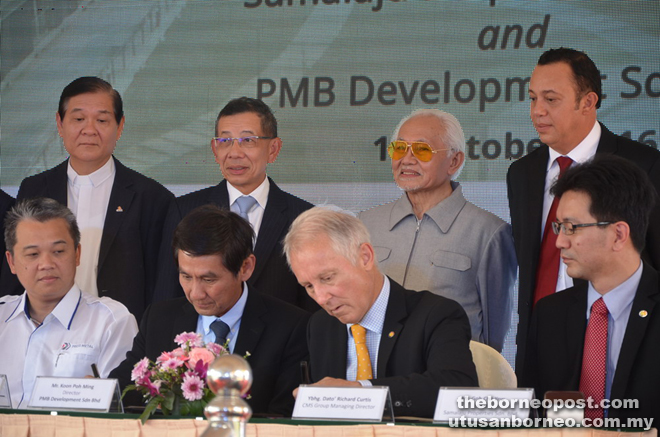
Taib (standing second right) and others witness the MoU signing ceremony between Samalaju Properties represented by Curtis (seated second right) and PMB Development by its director Koon Poh Ming (seated second left).
SAMALAJU: Energy-intensive Samalaju Industrial Park will play very significant role in shaping Sarawak to become an industrial state.
Head of State Tun Pehin Sri Abdul Taib Mahmud said the future of Sarawak would depend largely on the development of its northern region rather than the established areas in Sarawak.
“That is due to the existence of energy sources in northern Sarawak such as Miri and Bintulu,” he said when officiating at the official opening of Samalaju Resort Hotel here yesterday.
He added that the cheaper sources of energy would be able to attract more investments to the region in the future.
Sarawak in the next 20 years, he said, would have almost unlimited supply of energy, through the exploitation of hydro power while energy-based industries were still growing in Asia.
Taib said Samalaju was chosen partly on that basis and partly because it represented the future of Sarawak.
Cahya Mata Sarawak Berhad (CMSB) group managing director Datuk Richard Curtis, deputy state secretary Datu Ismawi Ismuni, CMS Group executive director Datuk Syed Ahmad Alwee Alsre and Bintulu Resident Muhamad Yakup Kari were also present at the function.
Samalaju, Taib added, would be able to get a fair share of such industries.
He said the private sector played crucial roles not only to support the projects and development in Samalaju but to support an idea that would hasten the pace of Sarawak’s development in the future.
“In the longer term, we will find high quality and long-lasting trend of development in the region stretching from Bintulu to Miri.
“When we found Samalaju, we were thinking of trying to attract bigger investors. People will find it necessary to relocate certain industries which are not fully dependent on the final stage of manufacturing but those that are in between the resource-based industry and the final consumer goods manufacturing.
“I think we are quite successful in getting them to come over to Samalaju,” he said, adding that Samalaju would continue to develop and its population growing more than anywhere else in Asia and thus would be able to attract more talents.
Taib said he had tried from the very beginning to avoid a temporary phase of development for Samalaju but to go for permanent development which would require very detailed planning for the future and to satisfy the clients.
“I see great things are going to happen in Samalaju. Bintulu has a good start but Samalaju will extend the prosperity and become a modern part of Sarawak where there are many disciplined workers able to attract professional and technical people to work with a certain kind of discipline.
“Samalaju should be able to emulate the success of Miri and match that success with greater opportunities for development.”
Samalaju Industrial Park has a steady growing cluster of energy intensive plants which include Tokuyama, Press Metal, Pertama Ferroalloys, OM Materials (Sarawak), Sakura Ferroalloys and Samalaju Port.
During the event, Taib also witnessed the signing of two special agreements with Samalaju Properties, the first with the Trustees of Methodist Church in Sarawak to buy 10 acres of land for a school and a memorandum of understanding with PMB Development Sdn Bhd which is part of Press Metal Group to enter into negotiations to consider the leasing of apartment units in Samalaju Eco Park.
